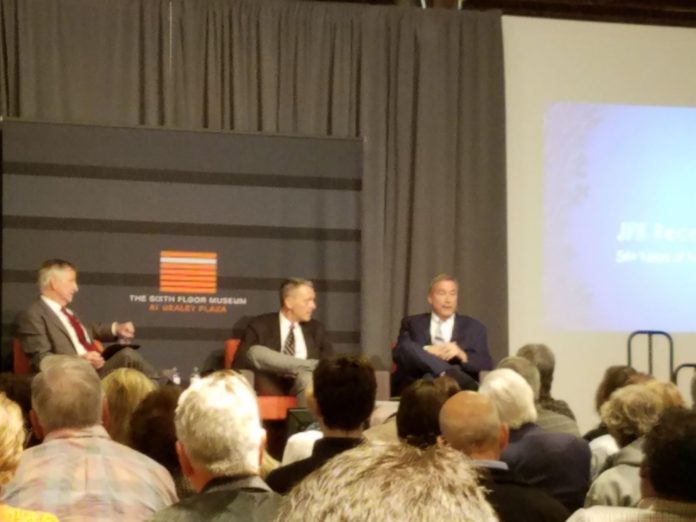Sixth Floor Museum at Dealey Plaza
411 Elm St.
Dallas
www.jfk.org
In Market:
The assassination and the conspiracy
You can blame Oliver Stone for a lot of crappy, overwrought pedantic cinema, but you can thank him for one thing. His dark 1991 blockbuster JFK may have unleashed a torrent of conspiracy nutcase theories, but it’s no coincidence that the next year Congress passed the JFK Records Act, giving the Feds 25 years to get their assassination ass in gear and release files on the event.
Even then, they begged birth certificate truther President Trump for more time and they now have until April 26, 2018, to release the remainder.
Thanks Oliver, but it may not make up for Any Given Sunday.
Still, as I sat at The Sixth Floor Museum at Dealey Plaza in Dallas on Saturday, Nov. 18, listening to authors Larry Sabato and Philip Shenon during a program called, What Has the Government Been Hiding? 54 Years of Secrets & the Release of the JFK Records, I’ll give Stone some credit. There was some interesting information here, even though there remain plenty of omissions and redactions.
Sabato, author of The Kennedy Half Century, noted one redaction that, after 54 years, simply didn’t make sense. It was a memo from the National Security Agency to an unnamed foreign government official – clearly in Latin or Central America.
“The day after the assassination, someone there writes to somebody high up in that government and says that the foreign nation’s delegation to Kennedy’s funeral was not senior enough for their liking,” he said. The name of that country is redacted.
The people involved in that decision are probably long dead, Sabato said, so why are we not allowed a peek into this footnote to history? “We’re adults, I think we can handle that. Don’t you?” Not according to Big Mommy government, apparently.
While that’s a footnote to history, the documents do shed some light on information to the assassination itself, in particular Lee Harvey Oswald.
Sabato said he learned some things about Oswald he had not known before.
“I had never realized that he had threatened to kill [President Dwight D.] Eisenhower. It was not reported to the FBI at the time, this was in 1957, he called a friend who was in the military and said that he wanted to kill Eisenhower,” said Sabato.
While no smoking gun, Sabato and Shenon both said the documents paint Oswald as a man with murder on his mind, citing his spousal abuse and his attempted assassination of former Gen. Edwin Walker a few months prior to the Kennedy visit.
And then there’s Oswald’s trip to Mexico City.
One record among those released showed how U.S. officials scrambled after the assassination to round up information about Oswald’s trip to Mexico City weeks before the assassination. Officials wondered whether Oswald had been trying to get visas at the Soviet and Cuban embassies in Mexico City in order to “make a quick escape after assassinating the president,” said Shenon.
A CIA message sent Nov. 24, 1963 — two days after Kennedy was killed — said an “important question” that remained unsolved was whether Oswald had been planning to travel right away or return to the U.S. and leave later.
The message said that although it appeared Oswald “was then thinking only about a peaceful change of residence to the Soviet Union, it is also possible that he was getting documented to make a quick escape after assassinating the president,” Shenon said.
Shenon notes that what happened on that trip may be key to Oswald’s later actions.
“We know from previously declassified files that Oswald – while he’s in Mexico – he’s meeting the Cuban spies and Russian spies,” said Shenon. “Mexicans were very supportive of Castro revolution. There’s reason to believe that Oswald talks about killing Kennedy when he’s in Mexico City.”
And then there’s plain ol’ cover your ass conspiracy.
“It is very clear for the record that the FBI and the CIA were determined not to get to the bottom of what happened in Mexico City,” said Shenon. “A lot of the documents that are still secret involve this Mexico City trip and what the CIA knew about Oswald in Mexico City.”
And the FBI – in particular J. Edgar Hoover – was determined to put forth the image that the FBI made no mistakes.
“[Hoover is] required to give a sworn testimony and he says that the FBI made no mistakes, that [the FBI] had no reason to believe this man, Lee Harvey Oswald, was a threat,” said Sabato. “Well, it turns out as he’s saying this to the Warren Commission under oath, he’s at the same time disciplining 17 agents in the FBI for having made terrible mistakes and having failed to [bring forward] evidence about Oswald.”
Now, 54 years after the assassination, Shenon and Sabato believe we’ll still be talking about the events of Nov. 22, 1963, for many years to come.
“We’re still arguing about the Lincoln assassination,” noted Shenon. “People come up with theories all the time, so go 150 years into the future and do you seriously think we won’t have new TV programs and new books on the Kennedy assassination?”






